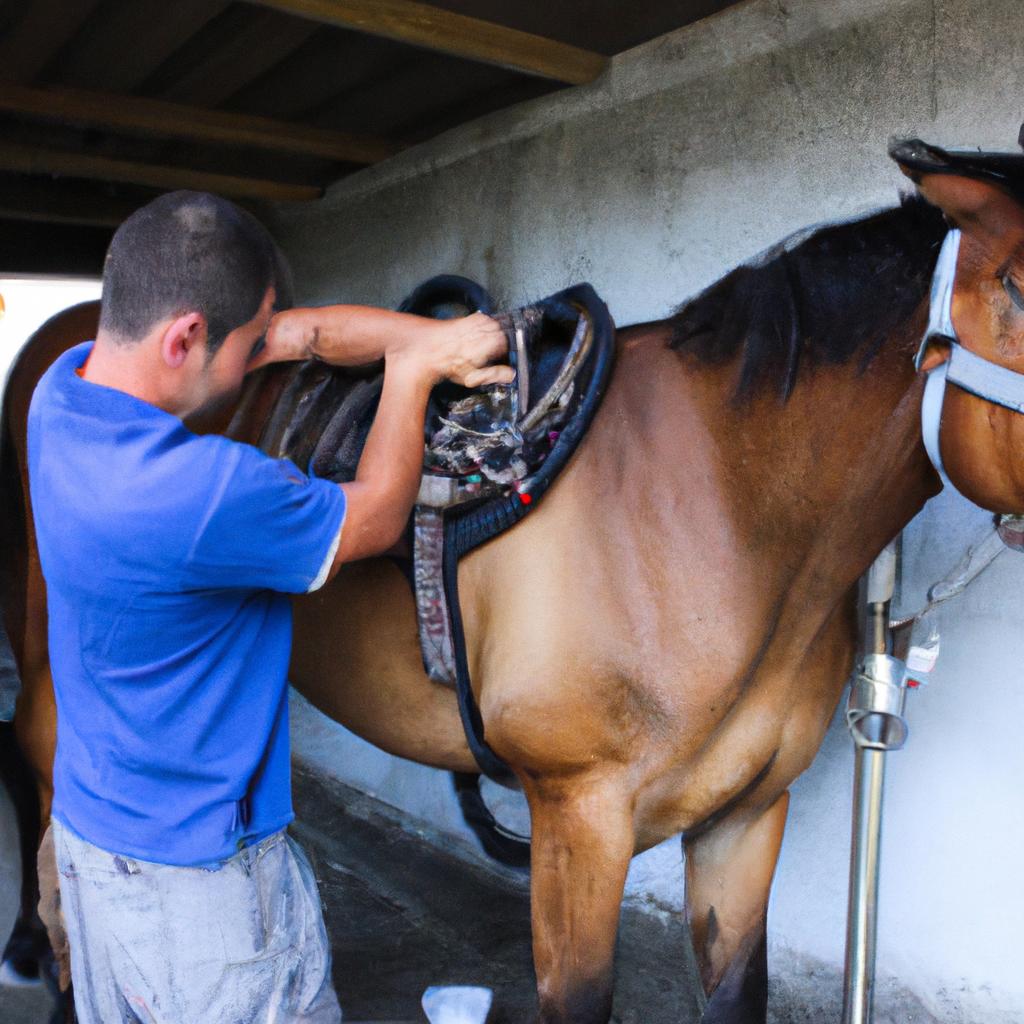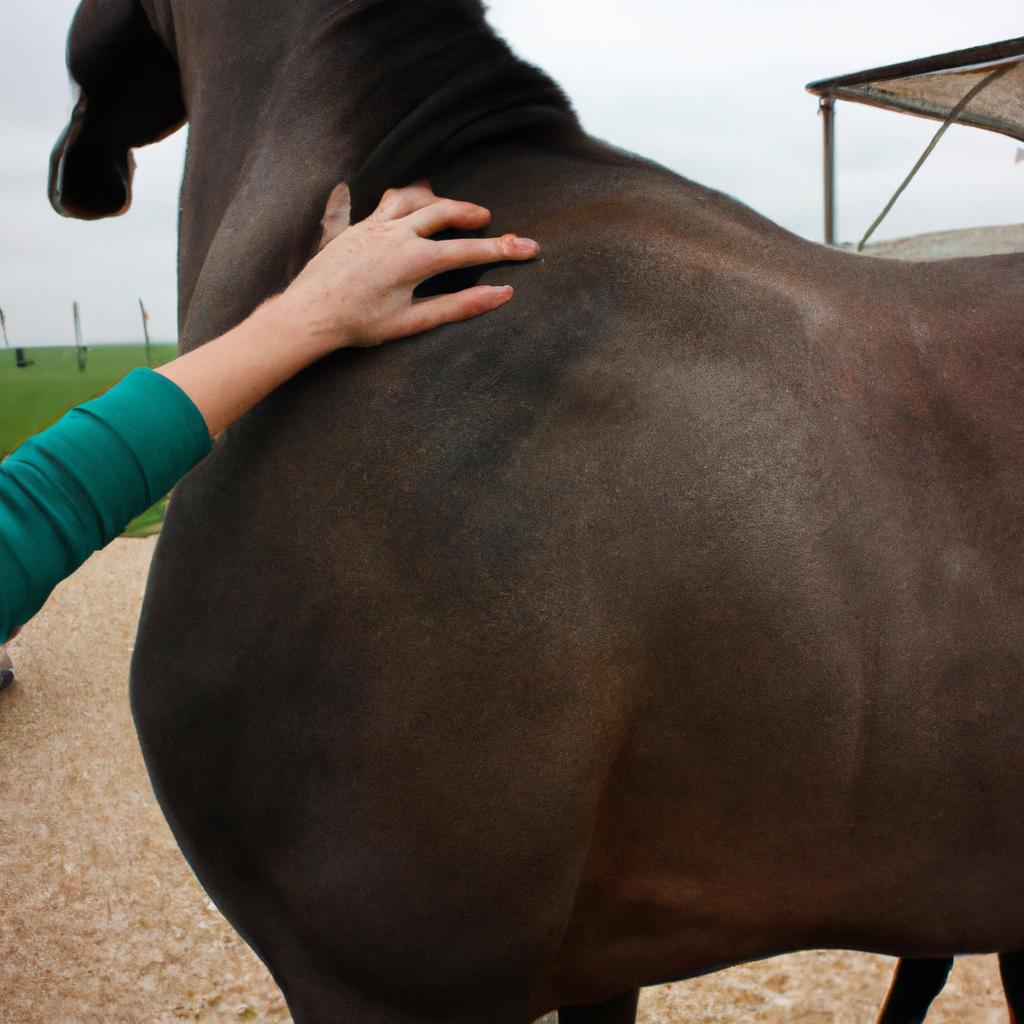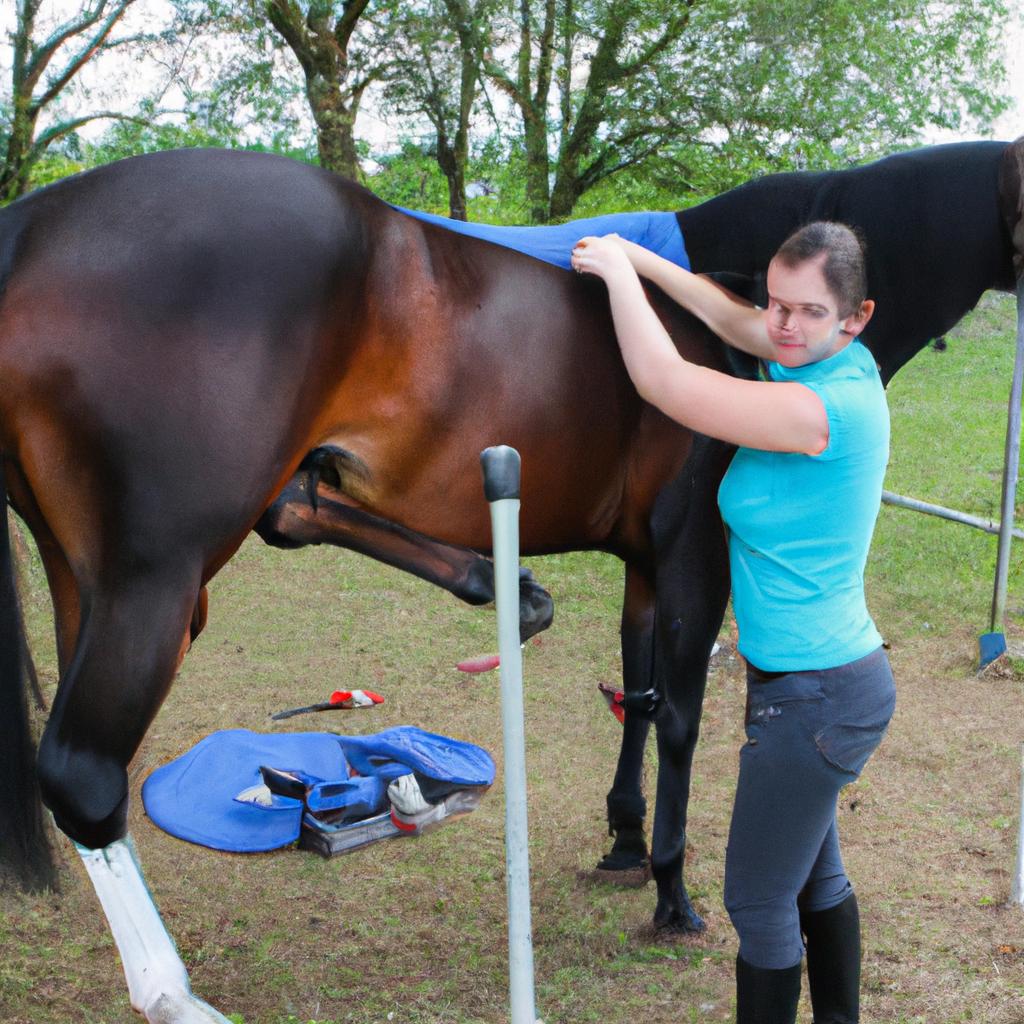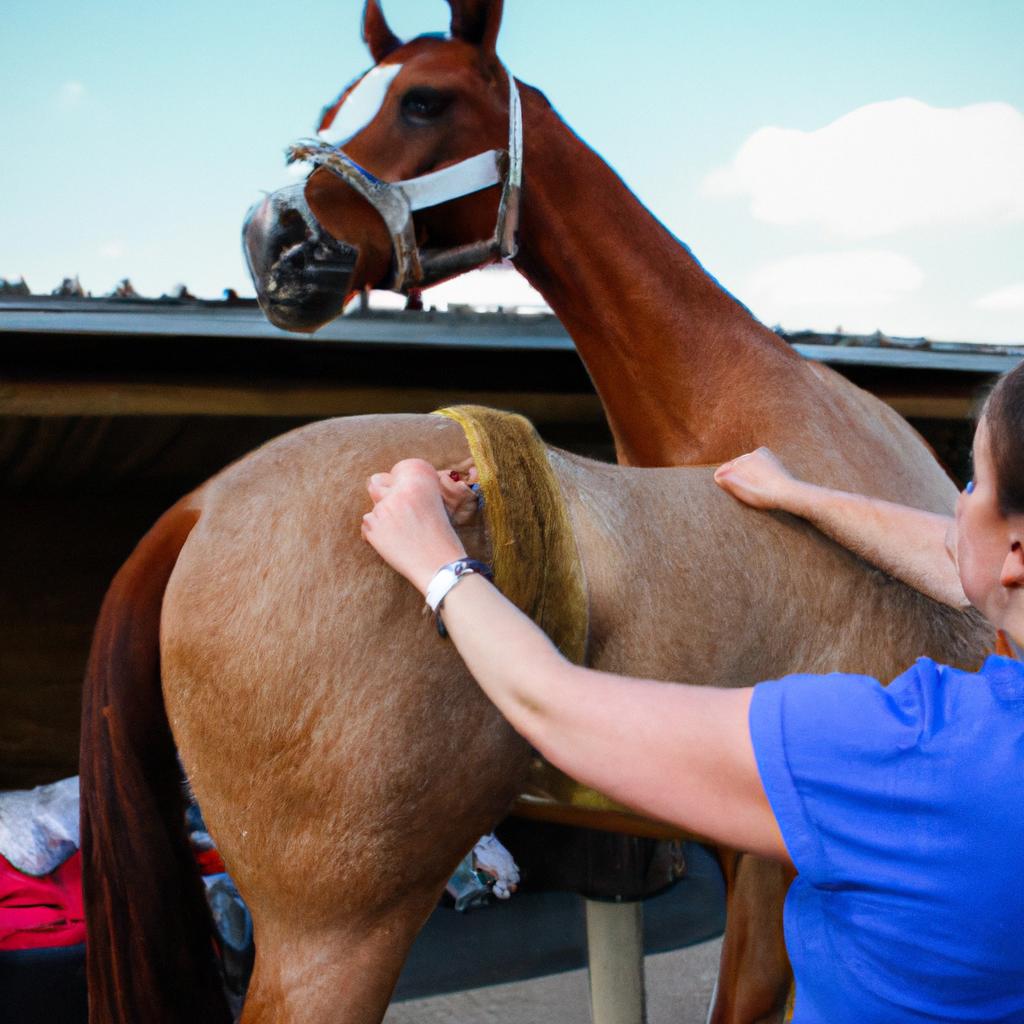Equine chiropractic is a specialized field of veterinary medicine that focuses on the diagnosis and treatment of musculoskeletal disorders in horses. By employing various techniques, such as spinal manipulation and soft tissue therapy, qualified equine chiropractors aim to restore proper alignment and function to the horse’s spine and limbs. However, finding a competent and knowledgeable equine chiropractor can be challenging for horse owners who may not be familiar with this branch of alternative veterinary care.
For example, consider a hypothetical scenario where a dressage horse named Apollo starts showing signs of stiffness and difficulty performing certain movements. The owner suspects an underlying musculoskeletal issue but is unsure about seeking traditional veterinary treatment or exploring alternative options like equine chiropractic. In situations like these, it becomes crucial to understand the techniques used in equine chiropractic and how to identify a qualified practitioner who possesses the necessary skills and knowledge to effectively address the horse’s condition.
In this article, we will explore some commonly employed techniques in equine chiropractic and discuss key considerations when searching for a qualified equine chiropractor. By understanding these techniques and factors, horse owners can make informed decisions regarding their horses’ healthcare needs while ensuring they receive optimal treatment from a trusted professional.
Understanding Equine Chiropractic
Imagine a scenario where a horse named Bella is experiencing stiffness, decreased performance, and difficulty bending to one side. Despite receiving traditional veterinary care, her condition remains unresolved. This is where equine chiropractic comes into play. Equine chiropractic is a non-invasive approach that aims to restore proper alignment and function of the musculoskeletal system in horses. By understanding the principles and techniques used in this field, owners can make informed decisions about seeking qualified equine chiropractors.
Equine chiropractic focuses on the relationship between the spine, nervous system, and overall health of the horse. The central idea behind this practice lies in the concept that misalignments or restrictions within the spinal column can interfere with nerve flow, leading to various health issues. Through manual adjustments known as manipulations, an equine chiropractor seeks to correct these misalignments to alleviate pain, improve mobility, enhance performance, and promote overall well-being.
To better grasp the significance of equine chiropractic, consider four key benefits it offers for horses:
- Pain relief: Misaligned vertebrae or restricted joints can cause discomfort and lead to chronic pain in horses. Equine chiropractic helps identify and address such issues through targeted adjustments.
- Enhanced mobility: Proper alignment facilitates optimal range of motion in joints, allowing horses to move freely without restriction or discomfort.
- Improved performance: By addressing biomechanical imbalances and restoring proper skeletal alignment, equine chiropractic can help boost athletic performance by enhancing coordination and balance.
- Holistic approach: Equine chiropractic complements traditional veterinary medicine by focusing on whole-body wellness instead of solely treating symptoms. It recognizes that optimal health depends not only on physical factors but also on mental well-being.
The table below provides an overview of common conditions that may benefit from equine chiropractic treatments:
| Condition | Symptoms | Potential Benefits |
|---|---|---|
| Back pain | Decreased performance, resistance to being saddled | Pain relief, improved flexibility |
| Lameness | Abnormal gait patterns, uneven weight distribution | Enhanced mobility, reduced lameness |
| Stiffness | Difficulty bending or turning | Increased range of motion, improved flexibility |
| Muscle tension | Tense muscles, restricted movement | Relaxation, decreased muscle soreness |
Equine chiropractic offers a non-invasive and drug-free approach that can address various musculoskeletal issues in horses. By understanding the principles and potential benefits associated with this practice, horse owners can make informed decisions about seeking qualified equine chiropractors. In the subsequent section on “Benefits of Equine Chiropractic,” we will explore how these treatments can positively impact the overall well-being of our equine companions.
Benefits of Equine Chiropractic
Understanding Equine Chiropractic: Techniques Used in Equine Chiropractic
To better comprehend the techniques used in equine chiropractic, let’s consider a hypothetical scenario. Imagine a racehorse named Thunderbolt who experiences stiffness and difficulty performing at his peak level. After thorough examination by a qualified equine chiropractor, it is determined that Thunderbolt has misalignments in his spine, particularly in the thoracic region. The chiropractor then employs various techniques to correct these subluxations and restore Thunderbolt’s optimal performance.
Equine chiropractors utilize several different techniques when treating horses with spinal misalignments or subluxations. These techniques are tailored to the individual needs of each horse and may include:
- Manual Adjustments: This hands-on technique involves applying controlled force to specific joints or vertebrae to alleviate restrictions and restore proper alignment.
- Flexion-Distraction Technique: In this method, gentle traction and flexion movements are applied to targeted areas of the horse’s spine, helping to decompress discs, relieve pressure on nerves, and improve range of motion.
- Soft Tissue Therapy: Alongside manual adjustments, equine chiropractors often incorporate soft tissue therapies such as massage or myofascial release techniques to relax muscles, reduce tension, and promote overall relaxation.
- Exercise Prescription: Equine chiropractors frequently work collaboratively with owners/trainers to develop exercise programs that assist in promoting flexibility, strength-building, and maintaining spinal health.
These techniques aim not only to address immediate issues but also prevent future problems from arising. By restoring spinal alignment and optimizing nervous system function through regular treatments by an experienced equine chiropractor, horses like Thunderbolt can achieve enhanced athletic performance while minimizing the risk of injury.
| Risk | Benefit | Emotion |
| ——- | ———— | ———- |
| High | Improved Performance | Excitement |
| ——- | ———— | ———- |
| Medium | Pain Relief | Relief |
| ——- | ———— | ———- |
| Low | Injury Prevention | Confidence |
| ——- | ———— | ———- |
As we explore the techniques used in equine chiropractic, it is crucial to consider the qualifications and expertise of practitioners. By evaluating their education, experience, and certification, horse owners can ensure they are entrusting their horses’ well-being to competent professionals.
Evaluating the Qualifications of an Equine Chiropractor
Equine chiropractic care has been found to provide numerous benefits for horses, both in terms of their overall well-being and their performance. For example, consider a hypothetical case where a competitive show jumper experiences decreased flexibility and poor range of motion in its hind limbs. After receiving regular chiropractic adjustments from a qualified equine chiropractor, the horse’s mobility improves significantly, resulting in increased jumping ability and reduced risk of injury.
When evaluating the qualifications of an equine chiropractor, it is important to consider several factors. Here are key points to keep in mind:
- Certification: Look for a practitioner who is certified by a reputable organization such as the American Veterinary Chiropractic Association (AVCA) or International Veterinary Chiropractic Association (IVCA). This ensures that they have undergone rigorous training and adhere to high standards of practice.
- Experience: Consider the number of years the chiropractor has been working with horses and their specific experience with your horse’s breed or discipline. A seasoned practitioner will possess valuable knowledge and skills gained through practical application.
- Professional Network: Find out if the chiropractor collaborates with other professionals involved in equine healthcare, such as veterinarians or farriers. A strong network indicates a commitment to comprehensive care for your horse.
- Client Testimonials: Seek feedback from other horse owners who have worked with the chiropractor you are considering. Positive testimonials can provide insight into the effectiveness and professionalism of the practitioner.
To illustrate further, here is an emotional bullet point list highlighting some potential benefits experienced by horses who receive appropriate chiropractic care:
- Improved joint mobility enhances athletic performance
- Reduced pain levels contribute to better quality of life
- Increased muscle flexibility aids in recovery from injuries
- Enhanced body alignment promotes optimal functioning of internal organs
Additionally, refer to this table showcasing different certifications offered by reputable organizations:
| Organization | Certification Offered |
|---|---|
| American Veterinary Chiropractic Association (AVCA) | Certified Animal Chiropractor (CAC) |
| International Veterinary Chiropractic Association (IVCA) | Certified Veterinary Chiropractitioner (CVCP) |
In summary, when seeking a qualified equine chiropractor, consider their certification, experience, professional network, and client testimonials. These factors will help ensure that your horse receives the best possible care.
Common Techniques Used in Equine Chiropractic
Imagine a scenario where a horse owner notices that their horse is experiencing stiffness and limited mobility. Concerned for their equine companion’s well-being, they decide to seek the services of an equine chiropractor. However, it is crucial to evaluate the qualifications of such professionals before entrusting them with your horse’s care.
When assessing the qualifications of an equine chiropractor, several factors should be considered:
-
Education and Training: A reputable equine chiropractor should have completed a comprehensive educational program in animal chiropractic care from an accredited institution. This training typically involves coursework in anatomy, physiology, biomechanics, and specific techniques used in animal chiropractic practice.
-
Certification: Look for certifications from recognized organizations within the field of animal chiropractic. These certifications indicate that the practitioner has met certain standards of knowledge and skill required to provide safe and effective treatments for horses.
-
Experience: While education and certification are essential, practical experience is also invaluable when evaluating an equine chiropractor’s qualifications. Consider how long they have been practicing as well as any specialized areas of expertise they may possess.
-
Professional Affiliations: Membership in professional associations or organizations related to animal chiropractic can further validate a practitioner’s credentials. These affiliations demonstrate a commitment to ongoing learning and adherence to ethical guidelines within the profession.
To illustrate these considerations more clearly and evoke empathy towards horse owners seeking reliable equine chiropractors, let us consider Sarah’s story:
Sarah noticed her dressage horse struggling with lead changes during training sessions. Concerned about his performance decline, she decided to consult an equine chiropractor specializing in sports medicine therapy. After thorough research on various practitioners’ background and credentials using the above evaluation criteria, Sarah chose Dr. Johnson – a certified equine chiropractor with over ten years of experience treating competition horses.
| Qualification | Evaluation |
|---|---|
| Education and Training | Completed a rigorous animal chiropractic program at an accredited institution. |
| Certification | Holds certifications from reputable organizations in the field of animal chiropractic. |
| Experience | Over ten years of experience treating competition horses, with a specialization in sports medicine therapy. |
| Professional Affiliations | Active membership in professional associations related to equine chiropractic care. |
By carefully considering these qualifications, Sarah was able to find a skilled equine chiropractor who helped her horse regain his optimal performance level.
As we have seen, evaluating the qualifications of an equine chiropractor is crucial for ensuring that your horse receives appropriate care. However, it is equally important to recognize the significance of proper training and certification in this profession.
The Importance of Proper Training and Certification
Common Techniques Used in Equine Chiropractic
Imagine a scenario where a horse named Bella is experiencing difficulty in performing her usual activities, such as jumping over hurdles. Her owner, Jessica, decides to seek the help of an equine chiropractor to address Bella’s discomfort and enhance her performance. In this section, we will explore some common techniques used by qualified equine chiropractors to alleviate musculoskeletal issues in horses.
Equine chiropractors employ various methods to manipulate the spine and joints of horses, aiming to improve their overall well-being. These techniques often focus on restoring proper alignment and mobility within the skeletal system. One commonly utilized technique is spinal manipulation or adjustments, which involves applying controlled force to specific areas of the spine using hands or specialized instruments. By doing so, equine chiropractors aim to reduce pain, increase joint range of motion, and promote optimal nervous system function.
- Soft tissue mobilization: This technique involves manipulating muscles and other soft tissues surrounding the affected area through massage-like movements. It helps reduce muscle tension and promote relaxation.
- Stretching exercises: Equine chiropractors may recommend specific stretching routines tailored to address individual horse’s needs. These exercises can improve flexibility and restore normal muscle tone.
- Rehabilitation exercises: After identifying underlying musculoskeletal issues in a horse, equine chiropractors may design rehabilitation programs consisting of targeted exercises that aid recovery and build strength.
- Electrical stimulation therapy: Some equine chiropractors use electrical stimulation devices that deliver low-level electrical currents to targeted muscles or nerves. This treatment can assist with pain management and facilitate muscle healing.
As illustrated above, these techniques are just a few examples of how qualified equine chiropractors approach their practice with care and expertise. They utilize combinations of manual manipulations, soft tissue work, stretches, exercise regimens, and innovative therapies to optimize horses’ musculoskeletal health and performance.
Moving forward, the subsequent section will delve into the crucial factors involved in choosing the right equine chiropractor for your horse. By considering these factors, you can ensure that Bella – or any other cherished equine companion – receives the best care possible.
Choosing the Right Equine Chiropractor for Your Horse
The Importance of Proper Training and Certification in Equine Chiropractic
When seeking an equine chiropractor for your horse, it is crucial to prioritize proper training and certification. Without the necessary knowledge and skills, a practitioner may not be able to effectively assess and address your horse’s needs. To illustrate this point, let us consider a hypothetical scenario involving two equine chiropractors.
In our example, Dr. A has undergone extensive training in equine anatomy, physiology, biomechanics, and chiropractic techniques specific to horses. They have completed a rigorous certification program recognized by reputable organizations such as the American Veterinary Chiropractic Association (AVCA) or the International Veterinary Chiropractic Association (IVCA). On the other hand, Dr. B lacks formal training in equine chiropractic but claims to possess intuitive abilities when working with animals.
To emphasize the significance of proper training and certification in equine chiropractic practice, we will explore four key points:
-
Knowledge of Equine Anatomy: A qualified equine chiropractor possesses comprehensive knowledge of the musculoskeletal system of horses. This understanding enables them to identify potential areas of concern accurately. In contrast, someone without adequate training may overlook critical anatomical details that could impact their treatment approach negatively.
-
Understanding Biomechanics: Equine biomechanics plays a vital role in assessing movement patterns and identifying irregularities that can contribute to discomfort or performance issues in horses. An educated chiropractor can evaluate how different joints interact during various activities like trotting or jumping. This expertise helps them develop tailored treatment plans based on each horse’s unique needs.
-
Technical Expertise: Certified practitioners are trained in specialized adjustment techniques designed specifically for horses’ bodies. These techniques require precision and skill to ensure safety and effectiveness during treatments. Relying solely on intuition without appropriate training may lead to improper adjustments or even exacerbate existing problems.
-
Safety and Ethics: Equine chiropractors with proper training prioritize the safety and well-being of the horse. They understand when to refer a case to a veterinarian or collaborate with other professionals, recognizing that chiropractic care is just one component of comprehensive equine healthcare. Unqualified individuals may overlook potential contraindications or fail to recognize when veterinary intervention is necessary.
To further highlight the importance of choosing a qualified practitioner, consider the following table summarizing key differences between Dr. A and Dr. B:
| Criteria | Dr. A (Qualified Chiropractor) | Dr. B (Untrained Practitioner) |
|---|---|---|
| Education & Certification | Completed recognized certification program in equine chiropractic | Lacks formal training or certification in equine chiropractic |
| Knowledge Base | In-depth understanding of equine anatomy, physiology, biomechanics | Limited knowledge regarding specific needs of horses |
| Techniques Used | Utilizes specialized adjustment techniques for horses’ bodies | Relies on intuition without established methods |
| Collaborative Approach | Recognizes when collaboration with veterinarians or other professionals is necessary | May not seek assistance from other experts if needed |
In conclusion, selecting an equine chiropractor who has undergone proper training and obtained relevant certifications should be a top priority for horse owners seeking such services. The extensive knowledge, technical expertise, commitment to safety, and collaborative approach offered by certified practitioners significantly contribute to effective treatment outcomes and overall equine health and welfare.
 Eq Muscle Release
Eq Muscle Release



